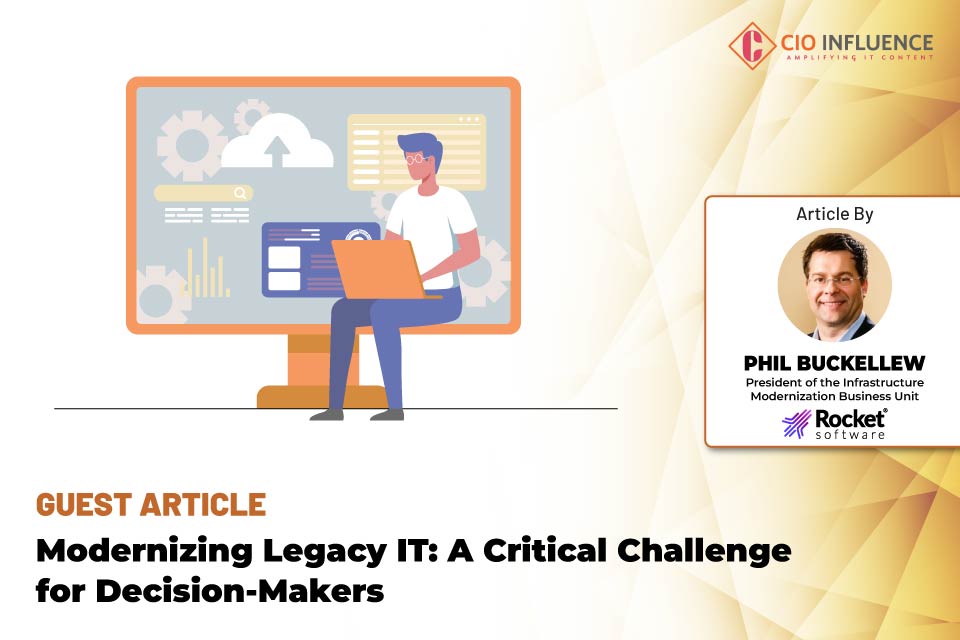Modernizing legacy IT successfully can be a tremendous boon for businesses. Yet, modernization projects are not easy, especially when they involve mainframes. Whether your strategy is modernizing applications on the mainframe, pursuing hybrid cloud, re-platforming applications, or attempting potentially risky and expensive rewrite projects, your strategy will require talented team members, efficient processes, advanced technology, and strategic partnerships. When one or more of these elements are missing, the risk of business disruption escalates dramatically.
In light of this reality, Rocket Software partnered with Forrester Consulting to better understand how leaders are approaching IT modernization today. The survey gathered responses between May and June 2024 from over 300 decision-makers who are driving their organization’s modernization efforts. The roles of those surveyed included CIOs, vice presidents, and directors in charge of initiatives across IT, security, operations, and tangential areas.
The survey’s findings shed light on the specific challenges teams are facing and what strategies they are employing in response. It also revealed what exactly is motivating organizations to allocate budget towards modernizations and push through failed attempts.
When companies get IT modernization right, they can raise performance across the board and integrate powerful mainframes with cutting-edge AI and cloud computing technology. They can also accelerate innovation at a time when competition is fierce, and agility is key. In addition, those who strike a proper balance between internal upskilling and external partnerships can align IT more closely to business objectives without compromising speed or safety.
Decision-makers struggling with IT modernization
Modernizing legacy IT presents numerous challenges. A key finding from the survey is that leaders are most concerned about security (41%), skills gaps (38%), and lack of proper tooling (30%) when it comes to modernization projects. They recognize how important it is to safeguard assets and equip team members to navigate modernizations and maintain new IT environments well.
Today’s IT ecosystems are more complex than ever, with governments implementing new regulations like the Digital Operational Resilience Act (DORA) that impose strict operational requirements on organizations. Concurrently, companies are gathering larger volumes of data from various sources while battling increasingly sophisticated and frequent cyberattacks. Navigating these dynamics to effectively design IT ecosystems can be daunting, especially as more workloads transition to the cloud.
Unsuccessful modernization projects are also costly to the business. According to the survey, one-third (33%) of respondents reported that modernization challenges led to decreased productivity. For those pursuing application rewrites as a means to modernize, the survey found 50% of these projects are delayed and 29% go over budget. What this reveals is that decision-makers are highly motivated to update legacy IT but are struggling to do so effectively. When modernization efforts fall through, it takes longer for companies to pursue new initiatives, recognize ROI, and deliver on customer expectations.
The reasons why leaders keep pushing forward
Although IT modernizations can be both challenging and daunting, they are worth the investment, according to survey respondents. The study found that 42% of C-suite executives are the driving force behind IT modernization because of their potential to transform business operations. Nearly seven in ten respondents indicated that they believe modernizing legacy IT is paramount to the business achieving its goals in the next 12 months.
Also Read: How DevOps Compacts the Software Development Lifecycle
Unsurprisingly, the goals leaders are trying to achieve differ from business to business. Survey respondents chose improved operational efficiency (51%) and better application integration (50%) as their top two desired outcomes. Next, leaders are wanting to leverage cloud-native, scalable applications (48%), improve customer experiences (45%), and elevate their DevOps pipelines (44%). When it comes to assessing modernization success, leaders reported a desire to experience fewer security, risk, and compliance issues (43%) and see increases in employee productivity (41%). Four in ten respondents hope to boost enterprise agility by updating legacy technology.
At the time of the survey, companies that were more than a year into a modernization journey reported enhanced cloud-native application capabilities (51%). Thirty-seven percent of respondents who just started a modernization project reported the same. Given that modernizations are often longer term endeavors, it’s critical for businesses to continually monitor progress, make adjustments, and adapt. Those who stick with projects reap the benefits and create a competitive advantage in the marketplace.
The role of partnerships
In addition to upskilling employees and adopting appropriate tooling, strategic partnerships play a vital role in modernizations. Every respondent to the Forrester survey indicated at least some dependence on external partners, which includes hyperscalers, MSPs, software vendors, external consultants, and systems integrators. When asked about what capabilities leaders think their external partners should have, the following landed in the top three: code and data modernization (83%), expertise in DevOps and CI/CD (79%), and open-source compliance (78%).
Leaders recognize that external partners can plug skill gaps and bring clarity to ambiguity. Those dealing with mainframes, in particular, can take advantage of experienced vendors who have executed countless modernizations and know the biggest pitfalls of pursuing digital transformation.
IT modernization can be a crucial strategic lever for organizations today. Updating enterprise IT is about much more than boosting performance in a single area. It’s how companies can align people, processes, and technology to drive significant value for the business as a whole.


